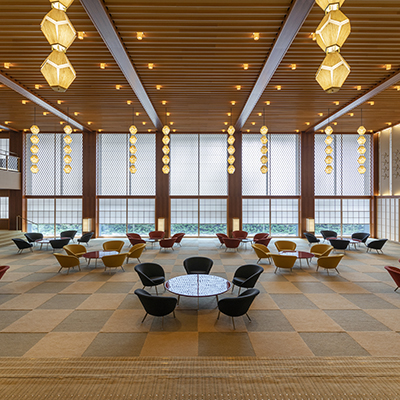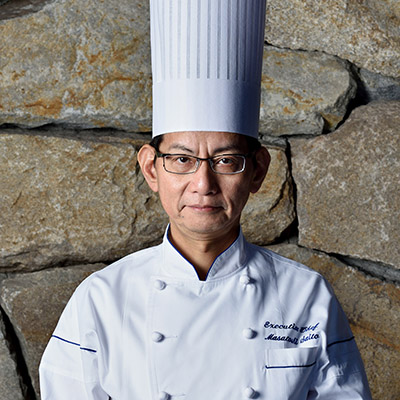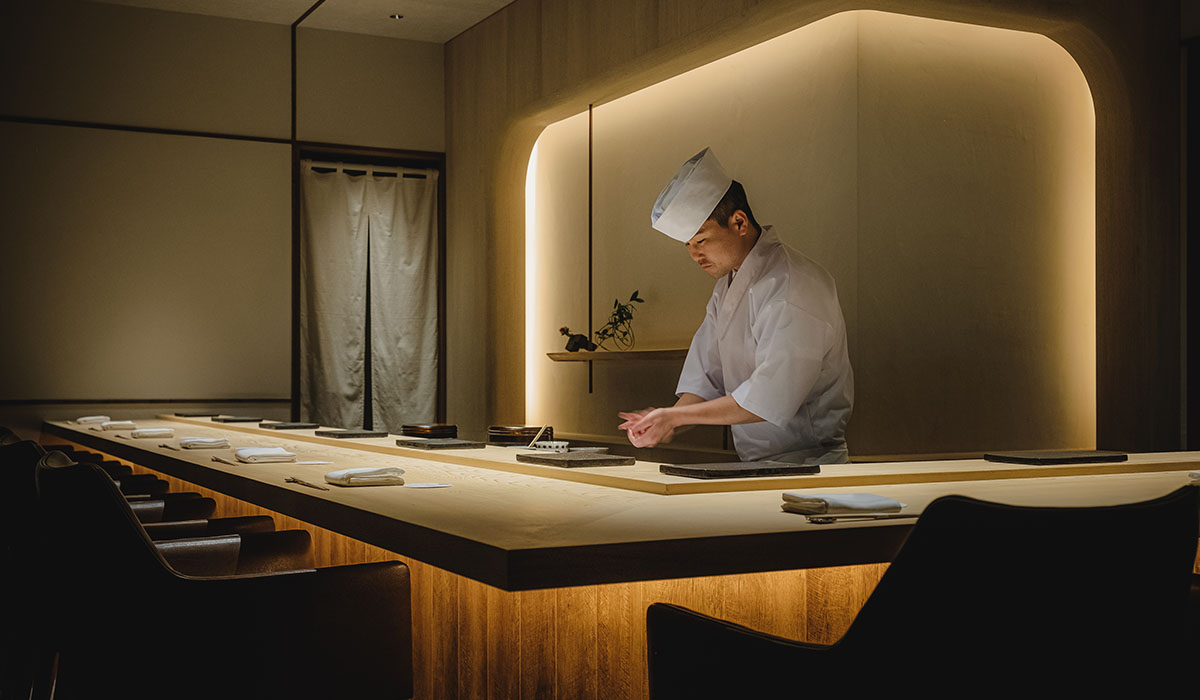
Gentle
Italian & Sushi Bar with an evolved stance
By Patricia Yarrow
The premise of Italian vegan dishes co-existing equally with omnivorial cuisine is an intriguing model. The premises are enhanced by relegating smokers to an outdoor terrace. Not to be overlooked would be a martini from the bar just alongside the entrance. I recommended the basement sushi bar for a quiet exploration of culinary artistry. GENTLE indeed.
Ambience
After a short stroll from exit B2 of Omotesando station down a curved side street, the screen of untrimmed trees and shrubs falling over the modern concrete structure of GENTLE Italian & Sushi Bar already promised an unusual approach. Pass through the foliage and the cozy bar just inside, the Italian restaurant unwrapped an updated Old World charm in subdued colors with overstuffed chairs calling for long conversations over elegantly kitted tables.We soon snuggled into the small alcove of a private sushi bar. The décor was austere, with white walls and honey-blonde shelving. We beheld our very pleased looking sushi chef awaiting us behind a single sturdy slab of glazed yakimono platter. A native of Aizu-wakamatsu-cho, he recently held sushi sway in a Japanese restaurant in Dubai. Soft overhead lighting was subdued over the chef and preparation area but highlighted our side of the counter. The hand thrown Japanese pottery (yakimono) will unite the entire culinary experience.
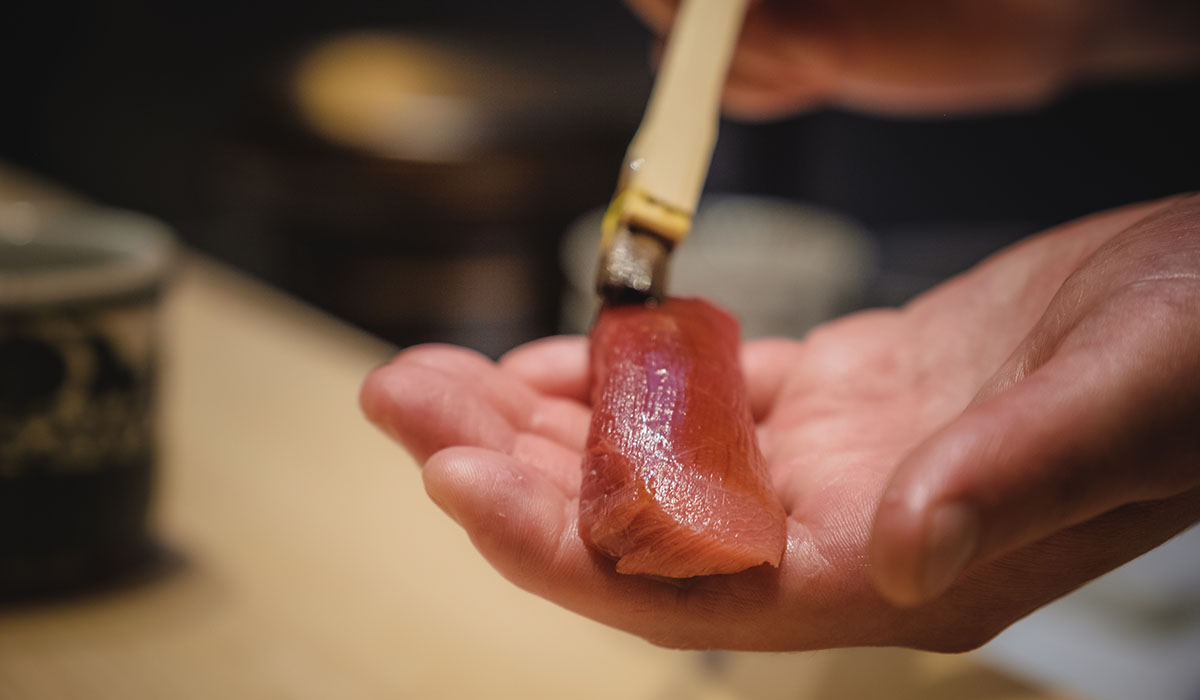
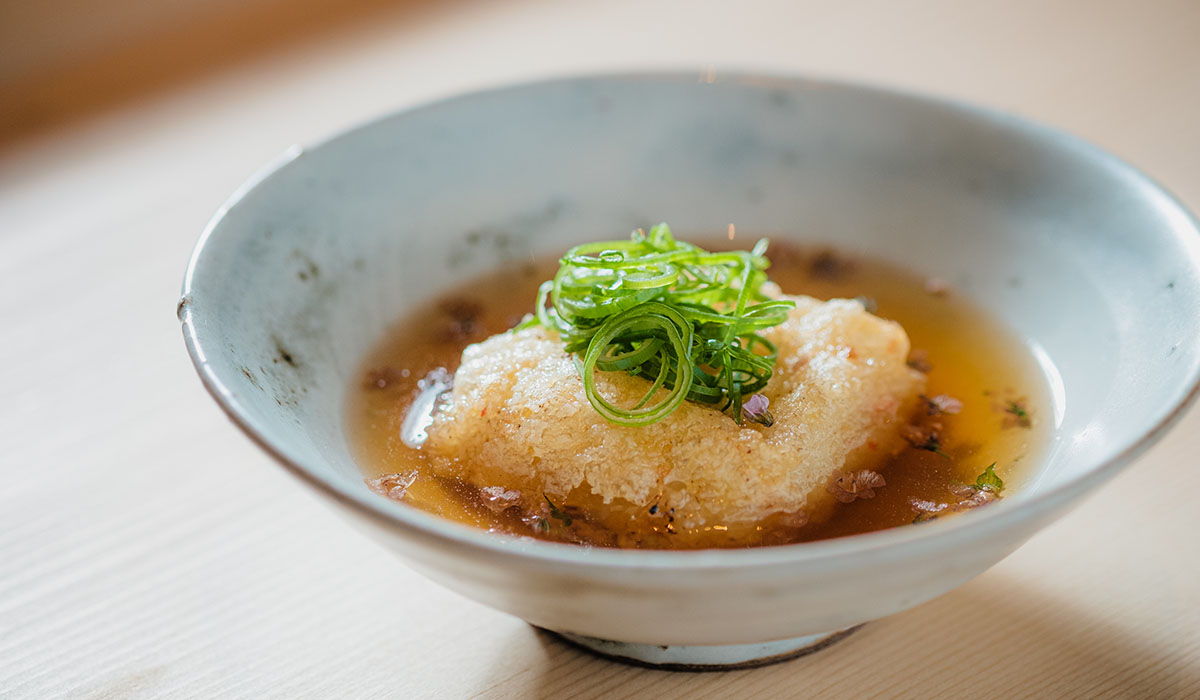
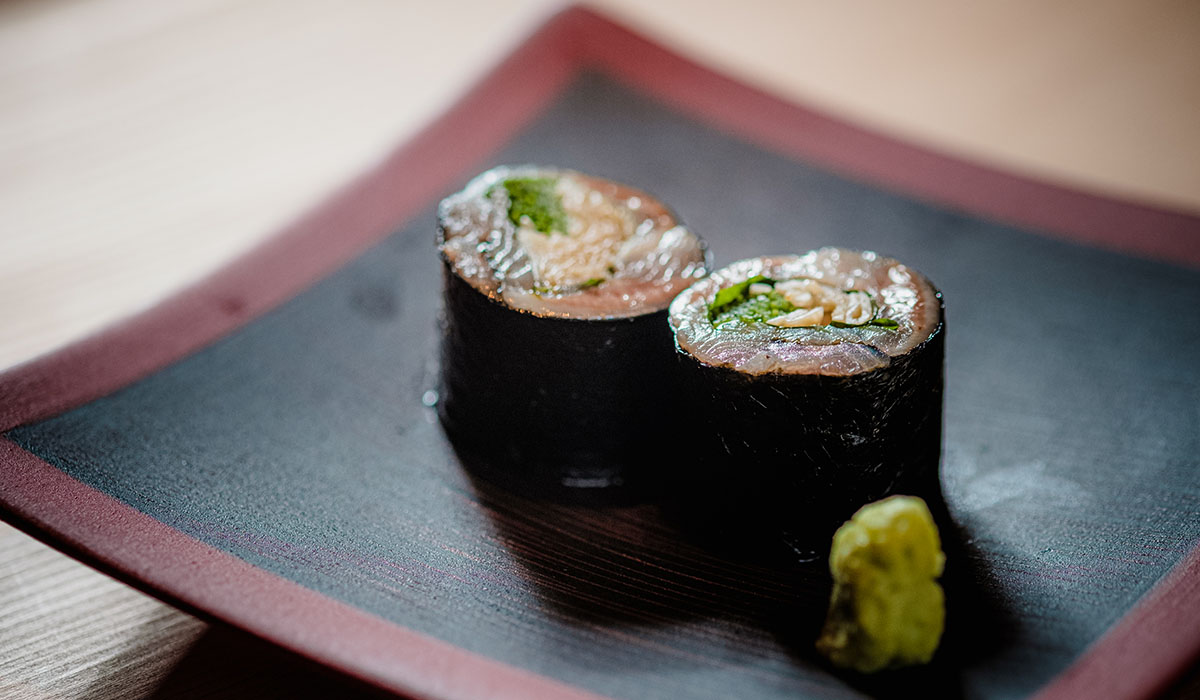

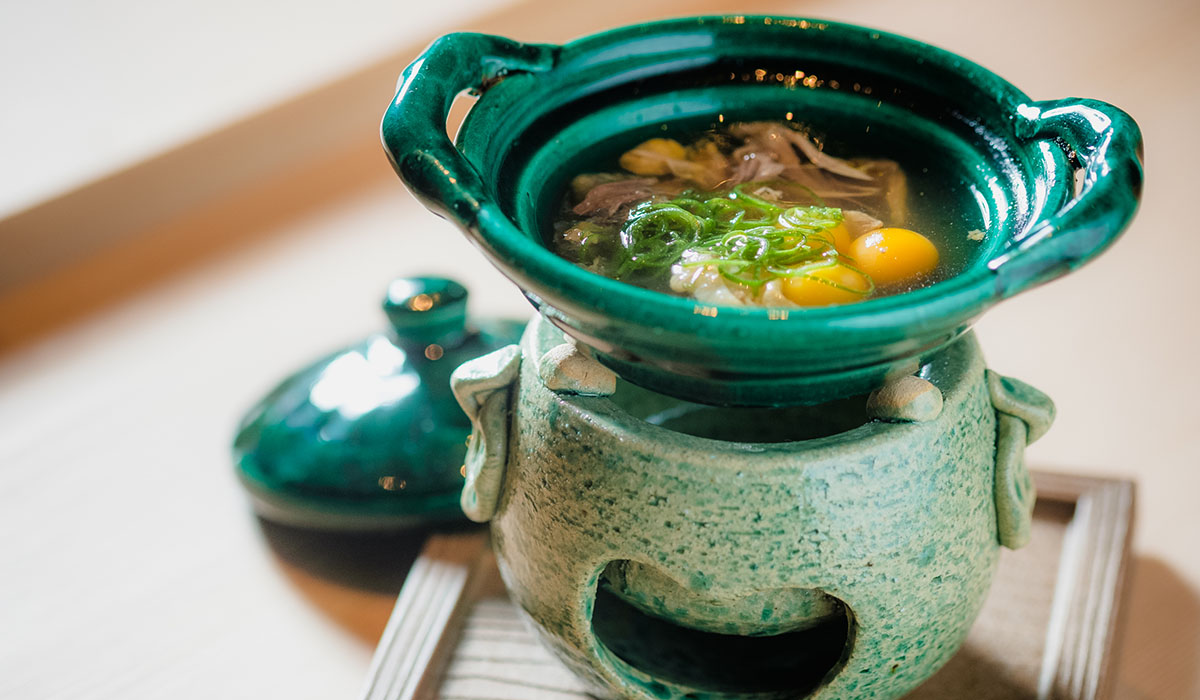
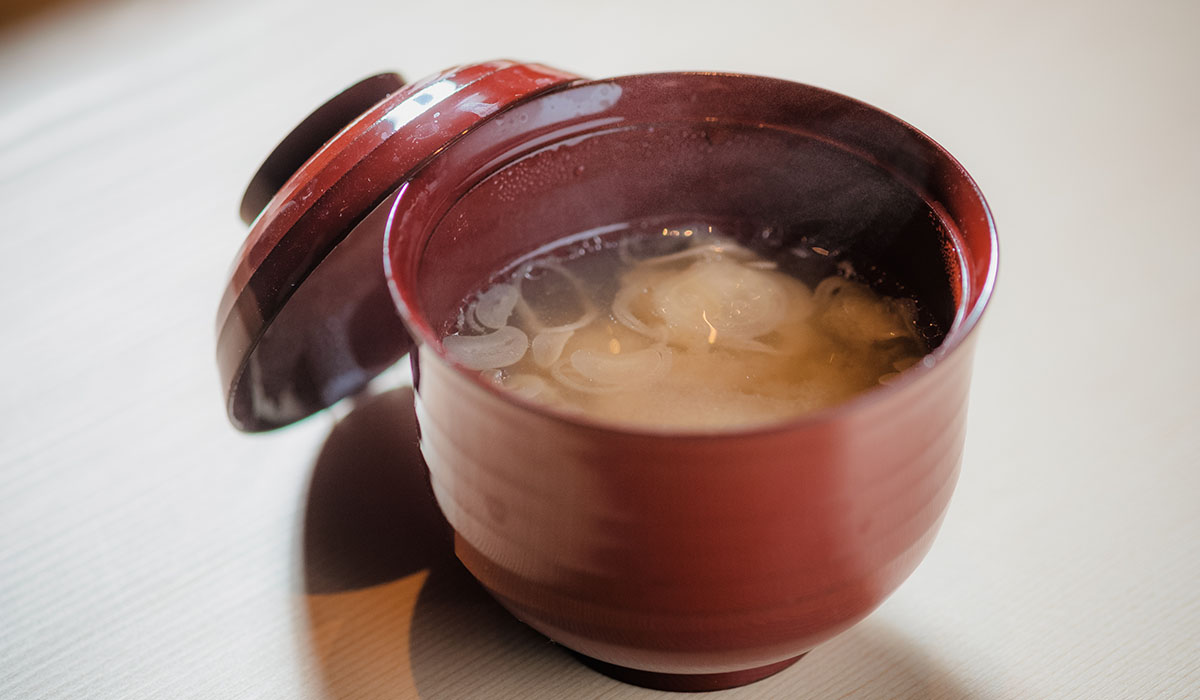
Cuisine
Saké #1-Kariho-kawasemi from Akita.The label sported the colorful kingfisher (kawasemi). This light saké will be succeeded by five others each meticulously matching the cuisine Chef Sato will assemble.
Our adventure commenced with an elegant cut glass covered bowl holding a wedge of chilled eggplant christened with a sprinkle of seaweed (nori) and a red crown of pickled heavier seaweed (konbu) in a delicate transparent sea urchin (uni) glaze.
Next, a single thread-sail filefish (kawahagi) and fish liver (kimo) sushi glistened on our sturdy platter. After some trepidation, we found the filefish’s liver delicate in flavor and texture, melding into the limpid, succulent kawahagi. The liver was smaller in summer and grows larger through winter, although the fish does not.
A round dish of gray and blue framed two slices of yellowtail (buri) sashimi from Hokkaido. From glistening shades of marbled garnet to ballet-slipper pink, it was only slightly oily, reflecting its summer fighting-weight. A mist of grated wasabi and daikon quietly sat guard to the side.
Saké #2-Aizu-musume in Fukushima.
A somewhat daunting trio of bottles with similar labels were brought out. The saké brewers had elected to use the same brewing process and sourced the rice from different fields (tanbo) in the area.
Paired wings of iridescent crème colored Spanish mackerel (sawara) from Hokkaido, lightly grilled and salted with a smidgeon of grated daikon formed a beautiful composition.
The intermediary platter next displayed gleaming white rice supporting a slab of bright red marinated tuna (akami) from Aomori.
A refreshingly rich flavor developed between the next presentation of herring (nishin) with ginger and a spring onion sliver inside.
A hand-thrown bowl of the same green and crème glaze work embraced two tender selections of Hokkaido salmon (sake) of an unusual marbled, light marmalade hue. Bright green Japanese pepper leaf (sansho) powder sprinkled the glistening surface. A little butter had been hidden inside the salmon. To the side, a bamboo pick held two greenish-yellow ginko nuts (ginnan). This was an astonishing treat, and with good reason. The rare and coveted Hidaka salmon (ginsei) is caught in the wild seas off Hokkaido. This celestial combination symphonically melded in a swirl of mild and wild flavors bringing images of the Hokkaido seas.
A small black glazed bowl followed with a helping of bright orange voluptuous beads of, appropriately, salmon eggs (ikura) topped with a tiny smidgeon of grated wasabi.
Saké #3-Shichida (seven rice fields) junmai saké from Shiga prefecture
This sake made with 100% Omachi rice embraced the lightly fried crunchy roll with tendrils of crab (kani croquette) inside. An alluring interplay of flavor and aroma transpired between the garnish of seasonal mustard greens (karashina) and sudachi lime.
A quiet intermission arrived with the arrival of unusually light mackerel (saba) sushi.
Chef Sato’s slender sushi knife moved into play delivering several long, silvery slices from the hefty side of bonito, or skipjack tuna (katsuo), to laying across as sushi, combined with a tinge of smoked soy sauce (shoyu).
Saké #4-Masamune 2011 from Yamagata is a subtle aged light saké.
A shallow basin held a delicate soup with slivers of the legendary matsutake winter mushroom, flavored with golden threadfin-bream (itoyoridai) with chopped parsley greens.
Perched on a wave of rich grayish ceramic, two cut rectangles of egg roll (tamago-yaki) incorporating green shreds of aosa seaweed accompanied an innocuous looking yet quite spicy mound of karami daikon winter radish.
The next sushi featured the lean Japanese whiting (kisu) from Kyushu marinated with kobu seaweed.
A small sushi of sea eel (anago) was a light pause before the final round.
Saké #5-Izumo “The Ouroku” nigori from Izumo.
Chef Sato expertly rolled bright red tuna (toro) with yellow pickled radish (takuan) in three colorful tekkamaki vinegared rice rolls.
After admiring the toasty texture of the black throat seaperch (nodoguro), we were encouraged to “smoosh” its buttery richness into the white rice.
Lastly, a charming mushroom soup (nameko akadashi) little round ‘shroom caps jostling rather adorably in a red miso soup held in a thin-walled red bowl.
Dessert proved a pièce de résistance as Chef Sato produced a showy display of chestnut (kuri) paste into a spaghetti-like Mont Blanc heaped over persimmon and fig with a sprinkle of Japanese pepper leaf (sansho) powder.
After a small cup of strong peppermint tea, we reluctantly bade farewell. Chef Kato came out from behind his counter to bid us farewell, feeling like an old friend as we bid arrivederchi and gochisosama deshita to his tender care.






